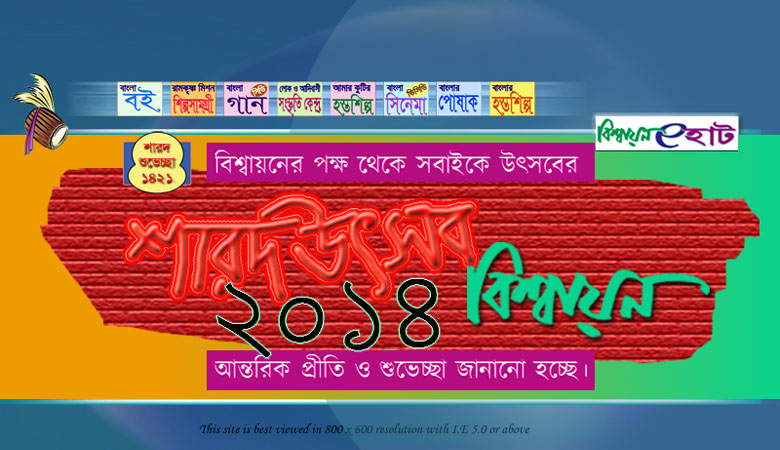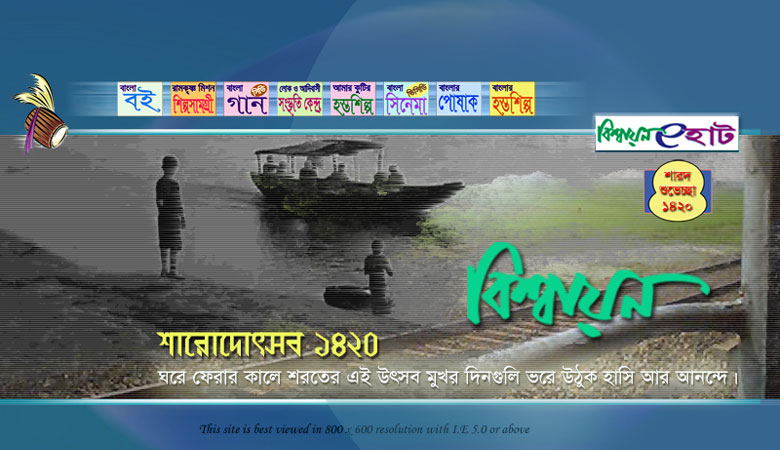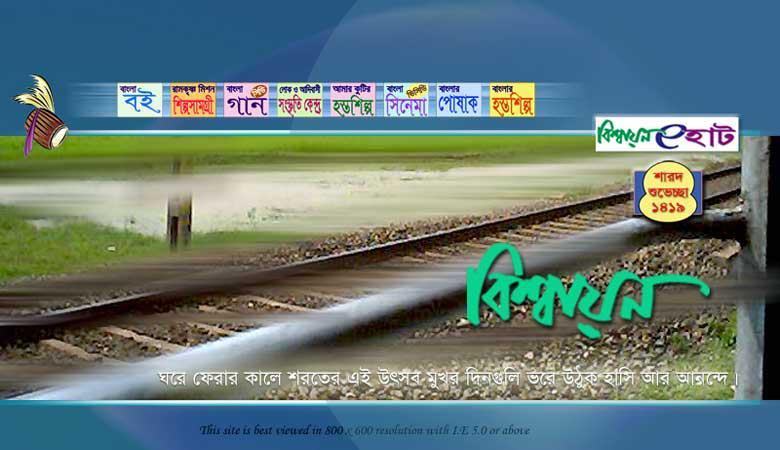To the readers
A story-type description on
The festival of light: the vibration of Post-Durga festival
The Kali-worship & Diwali
By Bangla Blogaru
(This article was written on 24th October 2014)

The Mother Kali (before finishing the idol)
Photo credit: Samir Bhattarcharya
Today is the day for Diwali, the all India Hindu festival. Yesterday this was the day for the Goddess Kali-worship or Shyama-worship. Shyama is another name of Goddess Kali (blue colored idol). This is significant to say that this festival is an extension of Sharod festival organized by the Bengali Hindu Peoples. In this day Bengali people arrange to place series of candles called Pradeep—
a candle-like lamps, on the roof, doorsteps or everywhere to light up
entire area and the recent Chinese LED lamp’s illumination is an extra
added advantage. The mind-boggling lighting and brightness of the
fireworks, the furious look of her, appearance and beauty of Goddess Kalika (Kali), the black idol, in the deep darkness of mid-night environment, the worship of Devi (Goddess Kali) in pandals (pavilion of Goddess) and temples, the night-stay by the dedicated, devoted Mother Kali lovers with an imaginative ghosts (the co-followers of Kali according to Kalika Purana or mythology), Dakini-Jogini (another kind of co-followers of Kali) and Shyamapoka (an insect), the mind-set of Bengali people utters a word “Maa! Maa!” (Hail Mom!), to say welcome for their favorite fest.


The followers of Mother
Kali (before finishing a look)
Photo credit: Samir Bhattacharya
For more pictures please go to http://banglablogaru.wordpress.com
The
uoollash (an expression of enjoyment) by the hard-core
outlaw hooligans do when the bombs (it’s called chocolate bomb) explode
for a tremendous irritating sounds produced by their crackers that
results an arrest of hooligans by the police. Children take sweets on
their palm leafs that produces a smell of firework’s powder. The table
bookings for veg or non-veg dinner in hotels or motels, in the home
cocktail party various types of tasty foreign or country’s spicy foods
with sufficient number of pegs of wine or liquor which is not forbidden
by the house wives because they allow hard drinks on that special day;
many bottles of two-litter-Coke or Pepsi are stacked for the
subodh-baboos’(gentle
and good guy) preferable soft drinks—all along the extended autumn
festival of the Bengali folks’ enjoyment have become a great
achievement!
A sudden bit produces sounds with skilled performance by the
dhakees and
dhoolees (drummers), people are deeply involved to concentrate into the uttering
mantras (the
Sanskrit Slokas) in the worship of Goddess, they, being converted from
stanyopayee (mammals) to
madyopayee (who
likes to drink always) prefer to drink wine or liquor openly or in
hidden or underground areas; they mix it with water in ready-made water
bottle which is available in any
paan-cigarette-shops and they enjoy full-fledged festive mood in a delightful manners, because in this event of
Kali-Aradhona (worshiping Goddess
Kali) the liquor or wine is allowed as per
puja norms, at the same time somebody who also is addicted to like the
pesad of baba he tries to get it as usual though it is forbidden by the law.
Perhaps Mother
Kali is the only rising goddess who is being worshiped by the folks of all classes from all professions among the
Hindu community.
From hooligans to politician, business man to industrialists, lawyer,
doctor etc. and localized cultural club/organization to high-profile
personalities— generally many of them either organize the
puja-event or go to the
Kali temples for worshiping Goddess.
We never understand how much mother
Kali is satisfied after having this
aradhona (worshiping),
it’s certain that she is fundamentally very much popular than others
and she must win among all other candidates if she would like to contest
in national election.
Pannalal’s mind boggling
Ramprasadian songs in
pandals on mother
Kali and its vibration creates a stimulated situation that makes people is energized to cling it.
The Bengali people wait for one month after fitting a candle on the
top of a long and erected bamboo stick fitted over the roof of the house
which is called
akashdeep that means the candle in the sky and
they light up the chains of candles one after one on that special day
of the year, also try to sweep out the darkness in their mind-set.
During the year they have forgotten their original living mother and
their duty is to set her in a home for old citizens, they are crying “
Maa! Maa!” and they are Bengalis who enjoys the festival in home or
pandals.

Ritwik Kumar Ghatak
The thoughts on
Kali (the term Kali or Kalika was adopted from Kal that means Time, likewise Mahakal is the Biggest Time) is the mythology-based philosophical analysis that depends on the basic structure of
Hindu
Bengali peoples’ own religious cultural identity which was produced
entirely on the concept of time, from where the great religious
philosopher,
Ramakrishna showed the path of multifariousness when he said “ So many opinions show so many paths.”
Ramprasad who was an authentic and aesthetically rich and creative poet-singer of
Kali-cult, as a human being he said to cultivate the unfertilized human land of mind (human soul) where the gold
(sona or in true sense it’s an
enlightenment) might be generated. The manifold pr-axis of mother cult which was still continued to 20
th
century that stirred many of the Bengali thinkers; it’s heard that an
experienced hard-core materialist who also made himself inclined to
Maa Kali
philosophy to be involved deeply. We know the history of foreigners who
were involved to practice the mother cult. The painting on
Kali
series by Tayeb Mehta has been purchased in exchange of huge money in
an art auction out side of India and that’s it, and wonderful
unbelievable incidence! The well-known Bengali film maker Ritwik Kumar
Ghatak did his works on the basis of collective consciousness during his
whole life which is related to the mother cult and it was included to
all films that he directed. For that reason, some body else says a joke
that the mother washes his brain! After the
vasan (immersion)
of idols, today those ‘Maa Maa’ callers and prayers of Bengali people
put an end to the yearly festivals through the enjoyment of another
family program after the Post-Durga-Fest.
________________________
Please Note:
Dewali- Dewali is all India festival of light, celebrated by Hindu Peoples.
Shyama- Shyama is another name of Kali Goddess who is blue colored idol.
Sharod festival- Sharod festival is the autumn festival when Devi Durga is worshipped.
Pradeep– It’s a candle-like lamp which is a tapering
container made of clay or bronze that contains mustard oil as fuel and a
slick cotton tape that sinks into the oil for firing on as like as wax
candle.
Devi– Devi means Goddess. In Bengali in colloquial form it’s said Deb (masculine gender), Debi, Debota (masculine gender) and Danob (Demon).
Pandal– Pavilion for goddess Kali idol is placed for worshipping.
Kalika Purana– Purana means mythology. So it’s Kalika Mythology. Sometimes Goddess Kali is called as Kalika.
Dakini-Jogini– Another kind of followers of Kali.
Shyamapoka- Shyamapoka is an insect called Shyama in relation to another name of goddess Kali which is mentioned here.
Maa- Maa means Mother.
Uoollash- Uoolash means enjoyment, pleasure, an expression of highest happiness.
Subodh Baboo– Subodh Baboo means the gentle and good guy. Subodh means gentleman who is modest and Baboo means Mr. (such as Baboo Subodh Chandra Mallik).
Dhakee & Dhoolee- Dhakee & Dhoolee are the drummers of Dhak and Dhol. Both Dhak and Dhol are drums on which player or drummer plays Boles skillfully by sticks on the occasion of worship.
Bole- This is a combination of different kind of sounds
produced by the beating with sticks or hand, fingers which player can
pronounce just alike speaking words.
Mantras- The Sanskrit Slokas (Sanskrit poems) that are pronounced at the time of Devi worship.
Stanyopayee- In Bengali Stanyopayee means mammals.
Madyopayee- This is a colloquial word that means that
anybody who prefers to drink wine or country liquor everyday, here it’s
an expression to mention a similarity to each other in lyrical form of
both words.
Paan- This is a leaf with vegetable ingredients for chewing after lunch or dinner normally.
Aradhona- Aradhona means worshiping.
Puja- Puja means to worship.
Baba- Here Baba is Lord Shiva. In Bengal folks are fond of Shiva, so they call him Baba, Baba means father, papa, daddy etc.
Aamro Pallob- This Aamro Pallob or Amer pallob is the foliage of mango tree. A small bunch of foliage is placed on Ghata – a container which is made of copper kept in front of God or Goddess.
Dhan-Doobba- Dhan is Paddy grain and Doobba is a single piece small green grass that generates between two long leaves of grass.
Pesad- In standard Bengali the word is Prosad that is converted to Pesad
in colloquial form. Generally fruits, vegetables, sweets, milk, water
(collected from Ganga River, previously River Ganges), flowers, mango
leaves (Aamro Pallob), green grass (Doobbo), food grains etc., sometimes country liquor (in case of Kali Puja) and bit of narcotic drug such as Ganja (marijuana), Charas, Hassis etc., and many more things are offered to God or Goddess at the time of worship.
Baba’s Pesad- Actually according to myths Shiva is
addicted to smoke marijuana and folks are fond of Lord Shiva, so they
like to share it as Baba likes it and they call it Baba’s pesad.
Pannalal- Pannalal Bhattacharya, a singer of Maa Kali songs and he was passionate to sing Ramprasadian songs.
Ramprasad- Ramprasad was an obsessive Kali Sadhok
(sagacious or wise), a poet and singer who wrote and sung so many songs
on Maa Kali philosophy in 19th century; he lived in Halishahor, nearest to Kolkata.
Vasan- Vasan is the immersion of the idol that happens in any River, pond or in Ganga.
Ritwik Kumar Ghatak – Marxist thinker and film maker
Ritwik Kumar Ghatak was the most important film director and he played a
significant role in the movement of new Indian cinema of late 50s. His
first production
Nagorik (The Citizen) was directed by him in the year 1950 and the last production
Titas Ekti Nadeer Naam
( The name of the river is Titas) was directed in 1974 after the
independence of Bangladesh in 1971. The Mother-Cult and the Collective
Consciousness were the main directives that carried out by his all films
in the direction to signify the role of content and film-treatment. His
most successful films are
Komol Gandhar, Subarnorekha, Jukti Takko Gappo (The Reason, Argument and Story),
Ajantrik, Titas Ekti Nadeer Naam etc.









































